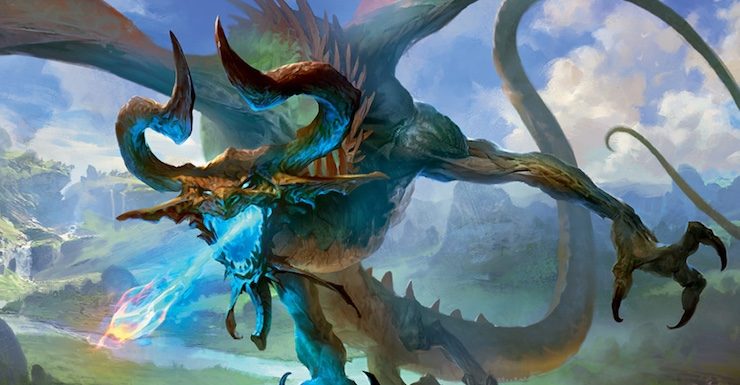If someone asked me how I got into fantasy, I’d bring up the summer of ’96. I was 12 years old and had just graduated elementary school. Enjoying one of the longest summers of my life. One day stands out vividly above the rest. It was hot, sunny—brilliant and full of possibility, in the way that only summer vacation can be. I was with my dad, driving to southern Vancouver Island so that he could meet with someone who worked for his online scriptwriting workshop. The drive was about an hour, but it felt shorter. I wasn’t looking out the window, or chatting with my dad; instead, my nose was buried in my mom’s battered copy of The Hobbit by J.R.R. Tolkien.
I was in the car with my dad, but I was also in Middle-earth alongside Bilbo, Gandalf, and the dwarfs. This might not seem like a remarkable introduction to fantasy, but it was for me. I grew up treating fantasy with disdain—dismissing it for being full of unicorns, princesses, rainbows, and the sort. (Who’d’ve thought that 20 years later I’d be looking for exactly those things in the books I read?) Instead, I was a remarkably loyal science fiction fan. However, Tolkien’s novel of loyalty and adventure, danger, magic, and friendship showed me the error of my thinking, and convinced me that, hey, fantasy is cool. I became a voracious fantasy reader after that—an obsession I still live with today.
However, my roots as a fantasy fan go back farther than that—which I’m only realizing as I write this article.
Rewind a couple of years to 1994. Spearheaded by Ms. Lukyn, the fourth grade teacher, a new game was spreading like wildfire in my elementary school. Magic: The Gathering was a Trading Card Game (TCG) that pitted two Planeswalkers against each other. The players took on the role of these wizards and faced off in combat by casting fireballs, drinking healing salves, and summing great beasts like Shivan Dragons or Sengir Vampires. It was easy to learn, cheap to start playing (or, the teacher had spare decks), and it ignited youthful imaginations. How else on the school grounds could you step into the robes of a wizard?
Each deck had its own personality—a way for the player to express themselves. Perhaps you relied on amassing a large army of small creatures, overwhelming your opponent through sheer volume. Maybe you were a dragonmaster, your opponents withering under the fiery breath of your thundering monsters. Or, perhaps you were cold and cunning, wearing your opponent down one card at a time until they crumbled beneath the weight of your spells. Whatever the matchup, each game of Magic was its own miniature fantasy story. I was hooked on fantasy before I even realized it. Years later, that love grew as I became immersed in the formative works of Tolkien, Barbara Hambly, Terry Brooks, and other fantasy masters.
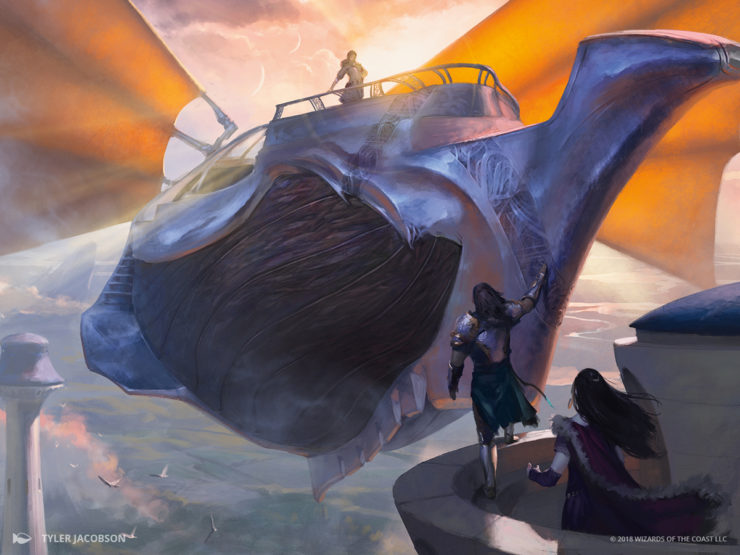
Nowadays, with 25 years under its belt, the narrative and lore behind Magic has grown exponentially. No longer is it contained to small, ephemeral battles between schoolchildren pretending at adventure—it’s now a multimedia affair featuring a core cast of characters, a Multiverse consisting of dozens of “planes,” each with their own conflicts, factions, and flavour, and myriad intertwine storylines. The Magic story spans novels, weekly short stories, comics, and an ever-expanding adventure that happens on the cards themselves. Altogether, Magic’s lore is one of the longest-running and most expansive fantasy stories ever told.
“In the early days of Magic storytelling, there wasn’t necessarily a lot of communication between different storytellers, nor was there much long-term planning about where Magic story might be in 2, 5, or 10 years,” Nic Kelman told me when I reached out to Wizards of the Coast to discuss the Magic story and fiction. “Over the years, we’ve been trying to make the story more consistent in tone and voice, make the Multiverse more consistent from a cosmological perspective, and plan out stories and character appearances further in advance.
“In terms of emphasis, I think the early days were less about characters and more about lore. Magic has been trying to emphasize characters more and more over the years. This is a trend we’ll be continuing in the future as we all believe characters are the heart of great stories!”
Kelman is the Entertainment Designer at Wizards of the Coast, and his job is to lead the creative team who creates Magic’s lore and story. “On the narrative side, I work with the world-building team here to plan out all of Magic’s upcoming story expressions as well as with the digital teams to help plan and execute any story elements in upcoming digital offerings. On the business and marketing side, I look for and develop new opportunities for Magic story-telling and coordinate with the Marketing team to promote all our work.”
For a long time, Magic’s story was written internally by Wizards of the Coast staff (with the exception of the novels, which were penned by contract writers), resulting in a experience that might suit from a plotting perspective, but was criticized for not being as polished as other aspects of the game. That all changed this year, though.
“We’ve embarked on the very exciting effort to gain the same reputation for fantasy fiction that Magic has for fantasy art. To that end, we’re now hiring first class, globally recognized fantasy authors to write our web fiction.” These authors include popular and award-winning fantasy authors Kate Elliott, Martha Wells, and Cassandra Khaw, and, most recently, Greg Weisman, who will be writing two novels set in the Multiverse.
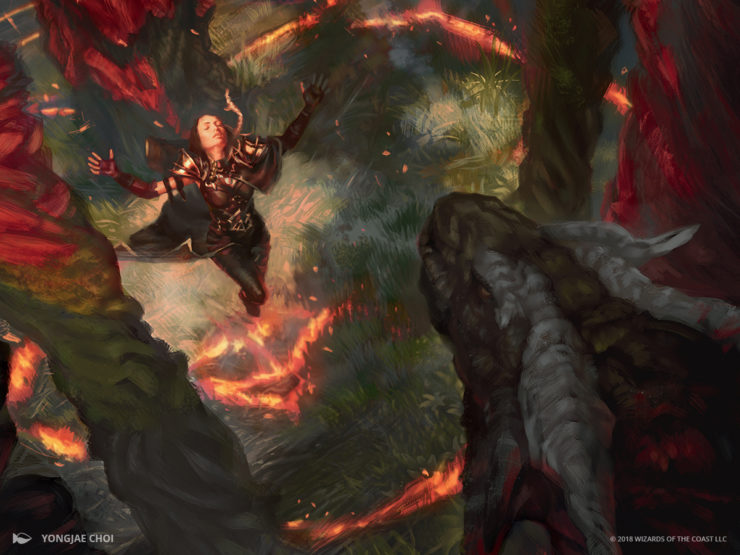
The modern Magic story, which began when the game’s 68th expansion, Battle for Zendikar, was released in 2015 and focuses on an Avengers-like collection of Planeswalkers called The Gatewatch. Until only recently, Magic was made up of “blocks”—a collection of 2-4 expansion sets that focus on particular story beats and game mechanics. This was done away with, and now each new expansion set stands on its own, bringing a new chapter of the ongoing story with it. You can think of it as a television show, with each expansion set being a season, and each short story or novel a new episode.
Since the formation of the Gatewatch, the story has focused on their adventures as they hop between planes fighting Eldrazi (imagine huge Lovecraftian horrors), evil Planeswalkers, and elder dragons. This structure allows Wizards of the Coast to tell an ongoing story, but also play around with different themes, tones, and narrative structures. As its name suggests, Battle For Zendikar featured a harrowing story about a plane fighting against an inexhaustible wave of Eldrazi. Shadows Over Innistrad was a Lovecraftian-noir mystery. Ixalan provided classic adventure and a search for the lost golden city of Orazca. Dominaria was a full-on return to Magic’s roots in epic fantasy. Recent sets, including Amonkhet and Core 2019, have focused on one of the game’s most iconic characters: villainous elder dragon Nicol Bolas. Magic‘s story is always pulling elements from the game’s history, which appeals to longtime players, but a major goal for Magic’s creative team is to also tell an ongoing narrative that’s welcoming and compelling for new players.
“We try to achieve that balance on both a micro and macro level,” said Kelman. “On the micro level, we try to make sure every story has at least one character who new fans can relate to without needing to know years of history and at least one character who established fans know and love. On the macro level, we try to plan out sets, settings, and stories so over the course of any given year, there’s going to be something for everyone.”
Hiring a new writer for each series of stories is just one of the ways in which Wizards of the Coast is ensuring that new players can hop on board without feeling overwhelmed.
The process for creating the story for each set is very iterative, said Kelman. “We usually begin with a meeting between me and the world-building team where we look at the world that’s been created for a set when it’s still in the concept phase—so the set is still a few years away at this point. At that meeting we look at the mechanical requirements of the set for its Planeswalkers and [unique legendary creatures] and we cross-reference that with all the other Planeswalker appearances in all media for the previous year and upcoming year. That lets us arrive at a few suggestions for which Planeswalkers could be in the set. We then go back and forth with [our Research and Development teams] on those suggestions a bunch of times as the mechanical set requirements become clearer.
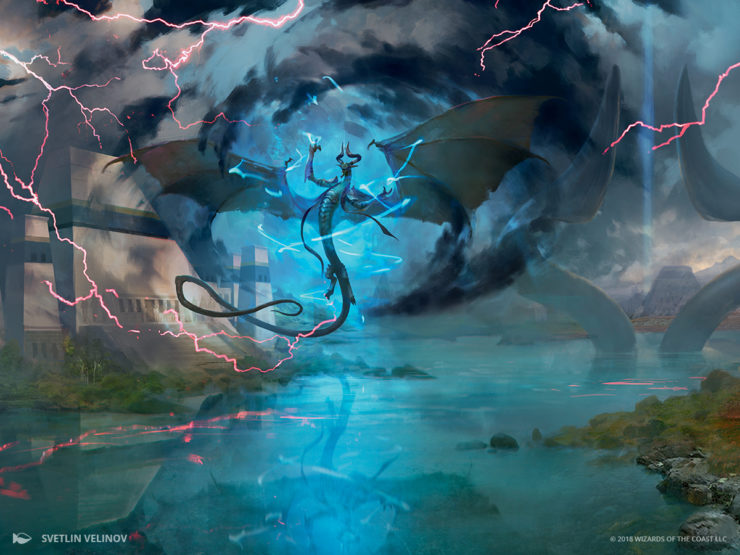
“Then we have several more brainstorming sessions where we throw around story ideas for the set, and when we have a ‘logline’ we like, we dive into it in earnest, plotting out the story in much more detail but still leaving plenty of room for set development. At this point we’re still at least 18 months out from the set.
“Once card concepting has begun and the set is more clearly locked in, that’s about the time that I begin looking for authors and we begin working on a more detailed outline internally. Then once the author’s on board, we hand that outline off to them and they begin work.
“The stories then come in and we have several rounds of revisions with the author where myself, Jenna Helland, and Doug Beyer have a look at the work and sync up on our notes which go back to the author.”
Wizards is known for its dedication to inclusiveness and diversity not only in its art, but also its worldbuilding and storytelling. Magic is a global phenomenon—with the game appearing in game stores around the world, and winners of the Pro Tour coming from Germany, Japan, Brazil, Sweden, Israel, and many more countries—and players representing humanity’s full spectrum and its many axes. Wizards understands how important it is for all of their players to be represented by the game they love—regardless of ethnicity, gender, sexuality, or any other defining trait. The Magic story is no different.
Already, Wizards of the Coast has brought on a slew of authors with distinct voices and styles, yet the Magic story has to remain internally consistent and true to itself. Managing that is less of a challenge and more of a game, said Kelman. “In my experience as a writer doing assignments, when you get handed a bunch of ‘must-haves,’ it’s like a writing exercise or prompt and the fun comes in trying to make the best story you can out of those pieces. The writers we’re working with are all very experienced and so far they’ve felt the same way. It’s a fun opportunity.
“When this is combined with the fact that we have great story-tellers in-house and even the ‘must-haves’ we’re handing off were, hopefully, well designed in the first place as strong story beats, the hope is that the author feels like they’re being given some really fun building blocks to play with.”
Once the Wizards team has created that list of “must-haves,” the authors are given an outline for their portion of the story. “I like to make sure the authors have as much freedom as we can possibly give them since that sense of ownership often produces the best work,” said Kelman. “That goes for characters too where I try to make sure there are always at least some new characters who play a major role in the story so the authors can have fun with them.
“In the end, by the time the author comes on board, there are major story beats which are locked in, and we have a very clear idea of what we think the overall story should be, but these are really great writers and if they come on and have great ideas about the story that still hit those major beats, we’re more than happy to change our plan to incorporate those ideas.”
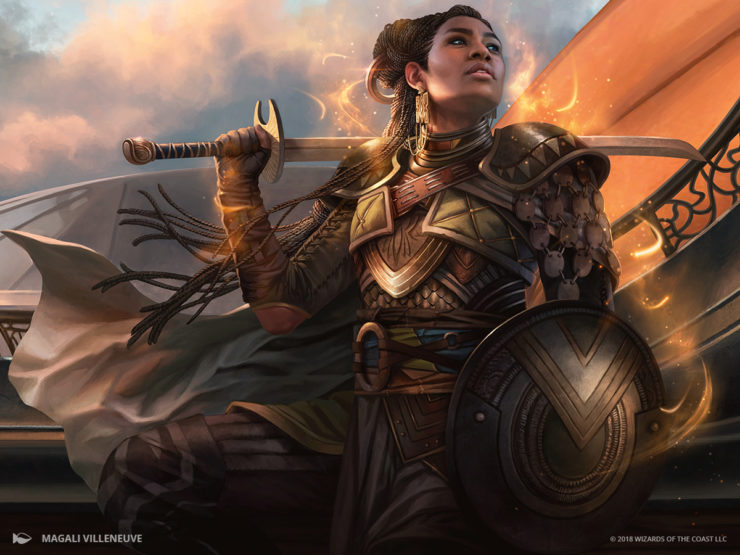
Creating the framework for the story allows the Magic creative team to create and manage the overall momentum of the ongoing story, but also leaves room for the authors to contribute their own flavour.
“I was given an outline for the overall plot, and some of the episodes had very detailed plot beats that I had to stick with, so they would fit in with and set up the ongoing story arc with Nicol Bolas and the Gatewatch,” said Wells, whose 2017 novella, All Systems Red, won both the Hugo and Nebula for Best Novella this year. Her contribution to the story saw the Gatewatch returning to Dominaria — a hugely popular plane that was the singular setting for the first several years of the game’s life. “This section on Dominaria is just a small part of the overall story. Nic and I did talk about the outline and make some changes as we went along, to incorporate suggestions from other people on the creative team. Other than those required plot beats, I had a lot of latitude with the structure and details of the episodes. Especially in the episodes with Tiana’s introduction and backstory, and her meeting Arvad for the first time, Shanna’s introduction, Raff’s introduction, and Teferi’s family and what he’d been doing after giving up his spark.
“I didn’t get to see most of the new cards or the card’s flavor text until after the stories were published, which was a precaution against spoilers getting out before the release. I did get to see some of the art so I could describe the new characters we were introducing, and I was nervous about having it on my laptop. I was afraid someone would steal it and I’d be inadvertently responsible for a disastrous leak, which I really really didn’t want to happen. Toward the end of the story I did get to see one card with text, for a character I needed to use in one of the episodes. Originally that spot in the story needed a bad guy, but the card text suggested that this character’s personality didn’t really work for a villain. So I ended up doing a more nuanced portrayal so he had motivation to be an antagonist in the story. I think the story was a lot better for it.”
Wells had a background in tabletop RPGs, but had not played Magic before being hired to write for the game, so she had little idea of just how important returning to Dominaria was for long-time fans. She enjoyed the setting a lot, however, and fan consensus was positive. “It was great working with a fantasy world that had so much variety,” she said. “So much detail, and such a long history. I had to work very quickly to meet the deadlines and it was an intense writing experience.”
Setting foot into a universe with such deep, established lore was challenging, said Elliott, who has been publishing fantasy novels for longer than Magic has existed. “I’m used to writing in worlds I have created. I know those worlds top to bottom and can make command decisions at any time when there is a character, setting, or plot question. Writing for Magic I had to constantly check my research and/or inquire with the design team to make sure I wasn’t violating already established lore or design. A few times I had to adapt or even abandon a plot element in order to make it work in the established lore.”
Khaw, who has stories in some of SFF’s best short fiction markets, like Clarkesworld and Fireside Fiction, has also written extensively for tech and gaming publications like Eurogamer, The Verge, and Ars Technica UK. Unlike Wells and Elliott, she has a long history with Magic. Her earliest memories of gaming include the black screen and green pixelated characters of the Vectrex or Gameboy. “I can’t remember half of what any of it was, but I remember being enraptured by things I didn’t quite understand. Magic: the Gathering, interestingly enough, was also one of my earliest gaming experiences. I played it obsessively, learning the strategies through trial and error—I was twelve and utterly dazzled.”
Jumping into Magic’s world wasn’t just a lifelong dream for Khaw; it also felt like something of a homecoming. How much research did a lifetime fan need to do before diving in? “Not as much as you’d think, really,” she admitted. “Like I said, I was obsessed with Magic for a long, long time. I owned all the novels. I devoured the anthologies. I obsessed over the flavor text. I pored over the material that Wizards of the Coast gave me, and then I ran up and barraged them with a thousand ideas, many of which were gently shot down by my infinitely patient editor, [Nic Kelman.]”
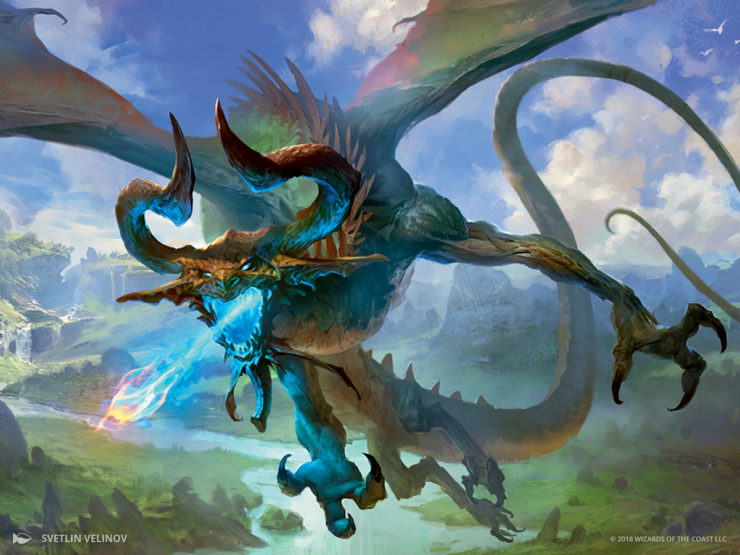
The best part of writing in an established world wasn’t creating the story itself, said Elliott, but the passionate, knowledgeable, and engaged fan base. “It’s wild how well people know the game—the cards, the timeline, the characters. It’s also great, because art (or games) that inspire that kind of excited loyalty are, I believe, contributing to a greater sense of connection between people and communities, and to my mind that is an excellent thing.”
Elliott was responsible for writing the origin story for fan favourite Nicol Bolas. Unlike Khaw, Elliott was only familiar with Magic because her kids taught her to play. How does an author new to the Multiverse even begin to familiarize themselves with a lore and history that stretches 25 years? Lots of research, said Elliott. “I read so much, so much, so much.
“Before I began, I had not realized Magic had a complex timeline in place, and while I had seen Magic fiction in the past I hadn’t read any back in the day. I had a lot of catching up to do. Starting with the basics, I reacquainted myself with the magic system and the general timeline of events. Once I settled on using Tarkir as the setting for the frame story, I dug through the online stories set in and adjacent to the Tarkir stories (especially [anything] with Sarkhan Vol, Ugin, and the hedrons). I also read and re-read all the material I could find on Tarkir, both the old Tarkir and the new Tarkir that emerges from the Fate Reforged storyline. Wizards of the Coast also provided me with the files they give to writers and artists.
“Nic answered questions I put to him, and questions he could not answer he directed to immensely knowledgeable people like Doug Beyer, Jenna Helland, Alison Luhrs, and Kelly Digges.
“Mostly I just crammed as much into my brain as I could so I would feel grounded as I wrote.”
For Elliott, it was about more than just playing in Magic’s playground—writing Bolas’ origin story gave her an opportunity to establish Magic lore, and Wizards was happy to give her the space to experiment. They wanted something the story about the Elder Dragon Wars to have “legendary flavour,” said Elliott, like a “tale being told long after those ancient days.” This was more than just an interesting framing narrative, it also gave Elliott and the Magic creative team a bit of wiggle room with specific story beats. “This way the facts of the story might have plausible deniability.”
Khaw is perhaps best known for her Lovecraftian noirs, like Hammers on Bone, which might at first seem like an odd fit for Magic—but that’s by design. Wizards is trying to showcase the breadth and depth of the universe they are created. “Wizards of the Coast gave me free rein to write as I would,” said Khaw, “embracing the denseness of my prose with nothing but occasional reminders that I should try to make my prose as accessible as possible. Having said that, we had to prune the story of my, uh, infinite love for descriptive gore.
“It’s easy to say ‘I am absolutely a super-fan who knows everything there is to know about an IP’ and think the work will be a flawless experience. But the truth is that it is very, very easy to end up laser-focused on the things you love best and gloss over the other details. That’s been the biggest challenge for me. Not writing tie-in for a TCG, but doing right by lore and history that has existed for literal decades—lore and history crafted by teams of writers.”
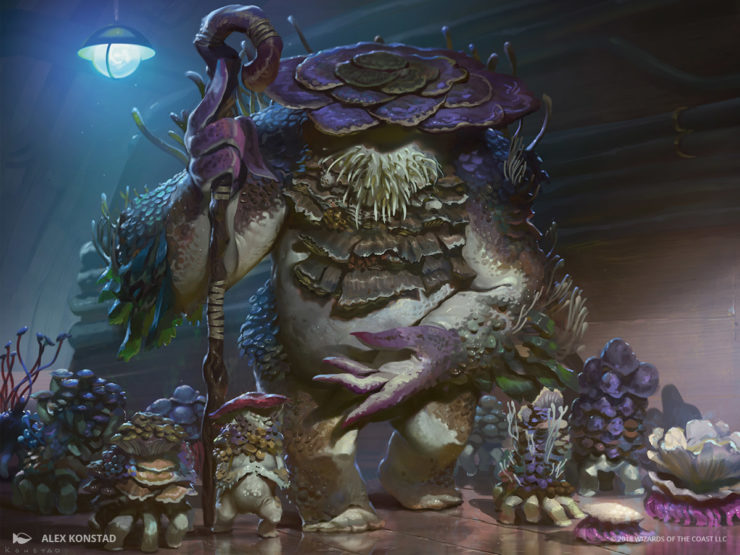
Magic is known among its fans for constantly evaluating its successes and failures and openly discussing its future plans for the game. Head Designer Mark Rosewater regularly answers questions from his fans on Tumblr, and regularly provides lengthy, in-depth, and searingly honest analyses about the game and its future. In a day and age where secrecy and controlled messages are becoming commonplace among large-scale entertainment creators, Wizards of the Coast’s openness is refreshing and genuine. This critical appraisal and desire to improve extends to the creative team’s direction with the Magic story.
“We have our own ideas in-house about which characters we love and want to see more of,” Kelman said, “but we also allow ourselves the flexibility to respond to positive fan feedback. You never really know who your next great character is going to be, so while we want to always have space to focus on the characters our fans (and we) know and love, we always want to set up opportunities to showcase new characters and chances for them to grow.”
What makes Magic’s story so compelling? “A sense of being unmoored and uncertain and excited to see what is coming along the horizon,” said Khaw. “Magic pivots around certain immutable facts, but it is constantly adding more to its history, more to its world. It grows by leaps and bounds with every block, yet all of it has a powerful sense of coherence. I guess more than anything else, it makes me feel like a child, wide-eyed with anticipation to see what’s coming next.”
Magic’s storytelling has come a long way from its early days. It’s no longer a plain fantasy world filled with generic tchotchkes and epic fantasy tropes. It’s grown into something way bigger and more expansive than Richard Garfield, the game’s creator, could have ever imagined. Magic was my gateway into fantasy—and as an adult, I’m stilled thrilled by its ever-expanding world. It’s still a game about individual personal stories, each one beginning and ending with the draw of the first card off the top of your deck, and ending with the final hit point of damage to close the game. But, it’s also an experience shared by the game’s millions of players—a story of community and hope, overcoming odds, coming together over a shared love of the game, and, of course, blasting dragons with lightning bolts.
Ready to jump into Magic: The Gathering’s story? Start with one of the following stories:
- “Return to Dominaria: Episode 1” by Martha Wells
- “Chronicles of Bolas: The Twins” by Kate Elliott
- “Unbowed, Part 1” by Cassandra Khaw
Aidan Moher is the Hugo Award-winning founder of A Dribble of Ink, author of “Youngblood,” “The Dinosaur Graveyard,” and “The Penelope Qingdom,” and a regular contributor to Tor.com and the Barnes & Noble SF&F Blog. Aidan lives on Vancouver Island with his wife and kids, but you can most easily find him on Twitter @adribbleofink and Patreon.










